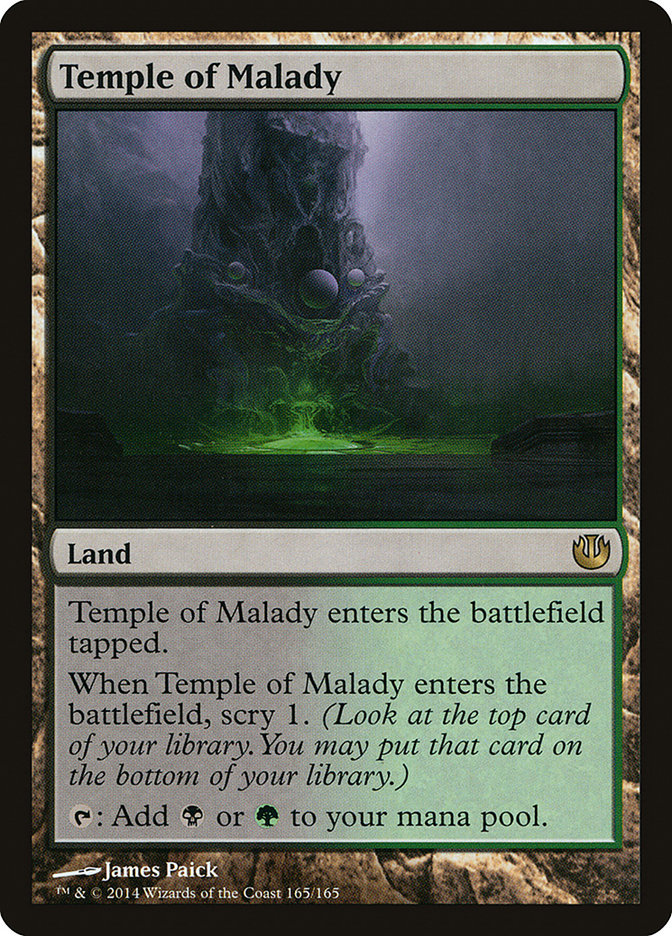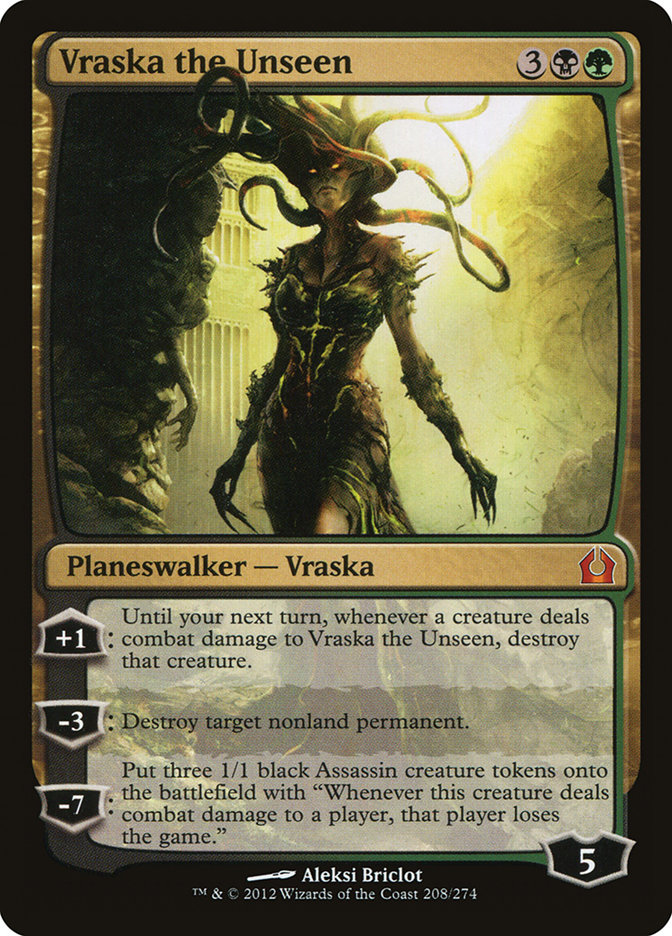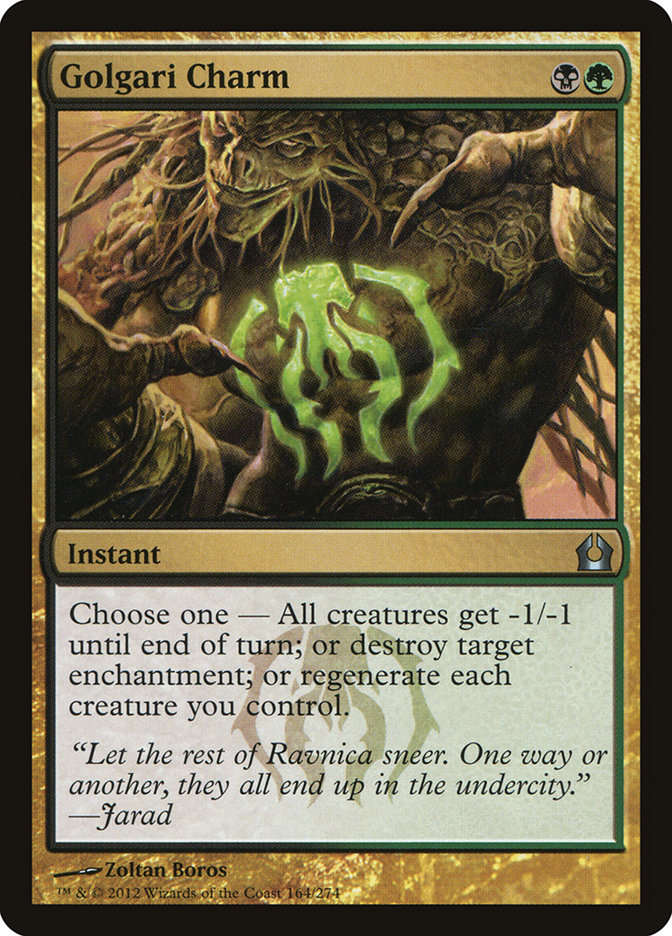We’ve taken our first Journey into Nyx, and there’s a lot of buzz around what we’ve found. There are a lot of big flashy effects that scream "build around me!" such as Athreos, God of Passage; Pharika, God of Affliction; and Keranos, God of Storms. There are also hyperefficient aggressive cards in Gnarled Scarhide and Mogis’s Warhound, not to mention the extremely scary Eidolon of the Great Revel. (Note: There is only one revel and not a revel more.) There are even some shiny new utility toys for control decks in the form of Deicide and Banishing Light.
There are also cards that are pushing the power barrier but either don’t have a home or are a bit difficult to make work like Battlefield Thaumaturge, Sage of Hours, and Prophetic Flamespeaker. I’ve even written an entire article about Dictate of Kruphix and its potential applications.
So what do I think is the best card from Journey into Nyx? What splashy effect am I most excited to build with? What powerful new card am I most pumped up to play?
What of art?
The cycle is finally complete, and while Temple of Epiphany will certainly make a splash in Standard, I would say that for the short term at least it will be more impactful in Modern. Temple of Malady on the other hand is going to make serious waves in Standard immediately. It may be a boring pick, but I’m a realist. Save for perhaps Mana Confluence, this is the card that opens the most doors and holds the most power. As any deck designer worth their salt will tell you, it’s all about the mana.
Skulls & Broccolis
Green has access to an engine that generates a huge advantage with a boost to mana production and fixing as well as a steady stream of cards and life and threats. I speak of course about Sylvan Caryatid and Courser of Kruphix, almost always complemented by some number of Scavenging Ooze.
On the other side of the coin, black has access to some of the strongest tools in the format. Mutavault aside, Thoughtseize is the best card in Standard, and Hero’s Downfall in a world full of giant monsters and threatening planeswalkers is precisely where you want to be. Add to that the second most potent card draw engine in Underworld Connections (second only to Jace, Architect of Thought into Sphinx’s Revelation) and there are some rich incentives to cast black cards.
I may also add that Courser with Connections is messed up crazy bonkers like wow. The cards were practically built for each other. For starters, they curve perfectly, as you ideally play Connections on four to get a card instantly. Then you’re getting all of these extra chances at getting a free land from the top of your deck and know what you’re drawing into before you have to do it, allowing you to time things out and pace your turns accordingly. Finally, there’s the cute "pay a life, gain a life" deal going on. The only question becomes what will run thin first—cards in your library or pieces of clean paper for keeping your life total? Add the dings and blings of Thoughtseize and Scavenging Ooze and you’ll be killing a lot of trees while winning a lot of games.
But the synergies don’t stop there. Thoughtseize is particularly good when you have either something to protect or something you need to prevent, and it just so happens that green can do both of those. Shielding your Courser or another big monster from removal is very strong. And these engines can often be a bit soft to sweepers, so being able to preemptively tag a Supreme Verdict is quite nice. Even the information it gives you can be worthwhile, letting you know when to commit more to the board and when to slow the game down and settle in for a grind.
Speaking of information and allowing you to pace a game and match your spells up against your opponent’s, that is precisely what Temples are exceptional at doing. The Rock-esque approach that is so natural for this color combination would do well to have that sort of card filtering, as the risk with such archetypes is often drawing your cards out of order or suffering mana troubles.
Keeping Nivix Cyclops In Check
Okay, so there may not actually be many Nivix Cyclops decks running around (anymore), but its true claim to fame is being blown up by one of the best positioned cards in Standard:
What makes the grass grow?
This card has been extremely good for some time now but hasn’t quite gotten to shine properly in large part due to Golgari Guildgate not being a substitute for the real deal. I have tried to make it work on more than one occasion to moderate success, and the same can be said of real players such as Reid Duke and Brian Kibler. What makes Abrupt Decay so attractive? Is it the look in its eyes, its chiseled jaw, or its perfect hair? Maybe those too, but mostly it’s how it matches up against the rest of the format.
When judging removal spells (or anything reactionary or defensive really), context is the most important thing to look at. For example, Doom Blade is a great card until the metagame is 90 percent Esper Control and Mono-Black Devotion. So how do we see the format through Abrupt Decay lensed Terminator eyes?
There are a lot of major players in Standard as we begin our Journey into Nyx. The "short" list looks something like this:
- Monsters
- Sphinx’s Revelation Control
- Black Devotion
- Blue Devotion (now splashing white about half the time)
- R/W Burn
- Blitz
- Naya Hexproof
- White Aggro-Midrange
- "Dredge"
With those in mind, let’s look at the list of the cornerstone cards of those archetypes that can be Decayed Abruptly: Domri Rade; Courser of Kruphix; Detention Sphere; Underworld Connections and Pack Rat; Chained to the Rocks; all of Hexproof’s Auras; Brimaz, King of Oreskos; Herald of Torment; and Nighthowler. Not to mention any small creatures from aggro decks, often helping lower devotion. A lot of the potentially scary cards from the new set can be dealt with via Decay as well such as Prophetic Flamespeaker and Dictate of Kruphix.
Even when Decay is "bad," it still kills threatening things like Scavenging Ooze and Nightveil Specter. The easier way to do it might be to list the cards it doesn’t match up well against, as that list is pretty short.
A more dynamic look at how it matches up would be to see what your deck is trying to accomplish. For example, if you are an Underworld Connections deck, then killing opposing Connections and Detention Spheres on yours will be that much more valuable. The same goes for Chained to the Rocks if you have giant threats to rescue from exile and so on.
Banishing Light is also a Nyx newcomer that will likely see a good amount of play. The new Oblivion Ring gives decks with white but not blue access to this effect, which is likely to be desirable in a world of enchantments, Gods, and planeswalkers. Its existence definitely makes Abrupt Decay’s stock rise.
Golgari United
What a charmer . . .
For many of the same reasons I like Abrupt Decay, Vraska the Unseen is also quite well positioned. It kills all the same stuff but can hit bigger things as well. Five mana is certainly not cheap, but it’s pretty strong to be able to pop a Jace, Architect of Thought or a Stormbreath Dragon on the way down and threaten to generate further advantage or even win the game on its own if left unchecked.
What a charm . . .
You’ll note that many of the problem cards you want Abrupt Decay for are actually enchantments (remember that this includes Courser of Kruphix and bestow creatures). It just so happens that one of the modes of Golgari Charm is to destroy an enchantment! Sadly, the alternate mode of "kill a creature with converted mana cost 3 or less" is generally going to be better than the Charm’s options. And the uncounterability of your spell that often is end stepped at a D-Sphere is actually a big deal it turns out. I will say that a split is certainly justifiable, and I would be remiss to not suggest having access to Charm from the board.
It can tag Burning Earth, Whip of Erebos, and Bident of Thassa in addition to the usual suspects plus any of the Dictates if one or more of them ends up finding a home. Then of course regenerating your team is quite strong against Supreme Verdict and the like. It can even be used against spot removal, though often at a tempo loss due to the creature becoming tapped and removed from combat. Lastly, -1/-1 is not too shabby either. There are certainly decks where it can be backbreaking, such as many of the white aggro decks or against Master of Waves. Or it can simply be used to one-for-one a Pack Rat before it gets active.
The Decks
Despite Temple of Malady only just being printed, B/G strategies already exist. That’s a testament to their strength and an indicator of things to come. One of if not the best deck in the format is Mono-Black Devotion, having won a ton of premier-level events over the past few months. With Bile Blight greatly blunting Pack Rat games, mirrors come down to Underworld Connections a huge percentage of the time. As said before, having access to Decay in matchups where both players have Connections or one has Connections and the other has Detention Spheres for them is absolutely huge. This is something that I tried to make work with Golgari Guildgate and Prophetic Prism, but it was just outclassed by white versions thanks in large part to Temple of Silence.
Here’s a recent example from Magic Online user Xerk, who played B/G Devotion to a 4-1 finish in one of the Standard Championship Qualifiers (note the two maindeck copies of Golgari Charm):
Creatures (15)
Lands (25)
Spells (20)
Sideboard

Another major player that could use a splash of Malady is G/R Monsters. Jund Monsters is already overtaking its two-color predecessor, and the better mana will likely continue the push in that direction. One could argue that the deck already has access to eight Temples and only plays five or so, but the difference between one that produces green and one that doesn’t is huge for this heavily green-based deck.
Creatures (26)
- 3 Scavenging Ooze
- 4 Ghor-Clan Rampager
- 1 Sire of Insanity
- 4 Elvish Mystic
- 4 Polukranos, World Eater
- 4 Sylvan Caryatid
- 4 Stormbreath Dragon
- 2 Courser of Kruphix
Planeswalkers (7)
Lands (23)
Spells (4)

You can also slow the deck down a bunch and shift the focus away from creatures, becoming a midrange control deck. This is a shell I’ve done some work with and even played in the SCG Season One Invitational in Charlotte. Reid Duke has toyed with this concept as well, and Chris VanMeter, who was my original inspiration for exploring the shell, played the following version of it in this Versus video. For all of our sakes, please pretend he didn’t jam four copies of Mana Confluence in his slow tapout midrange deck that already deals itself a lot of damage.
Creatures (15)
Planeswalkers (1)
Lands (25)
Spells (19)

I mentioned that Reid Duke toyed with this shell a bit, but he ended up taking it in a slightly different direction, using white instead of red. He still gets all of the goodies that black and green together gives you, but by giving up Rakdos’s Return and the red removal he gets access to one of the most powerful cards in Standard: Elspeth, Sun’s Champion. Archangel of Thune is also a welcome complement to the green-based shell with Courser of Kruphix and Scavenging Ooze. You can see him discuss the list in this deck tech from the Invitational.
Creatures (18)
- 4 Scavenging Ooze
- 2 Obzedat, Ghost Council
- 2 Archangel of Thune
- 2 Polukranos, World Eater
- 4 Sylvan Caryatid
- 4 Courser of Kruphix
Planeswalkers (3)
Lands (25)
Spells (14)

Or you could do it like Mullibok on Magic Online, who went 4-0 in a Daily Event with straight G/B Midrange. Who needs a third color anyway?
Creatures (17)
- 2 Scavenging Ooze
- 4 Polukranos, World Eater
- 4 Sylvan Caryatid
- 4 Reaper of the Wilds
- 3 Courser of Kruphix
Planeswalkers (2)
Lands (25)
Spells (16)
- 1 Putrefy
- 4 Thoughtseize
- 4 Abrupt Decay
- 2 Underworld Connections
- 1 Golgari Charm
- 3 Hero's Downfall
- 1 Bile Blight
Sideboard

If you want to push the limits of what midrange is capable of, Reanimator may be the Temple of Malady archetype for you. Another Magic Online list comes from snowsk82000, who went 4-0 with a much more focused reanimation strategy as opposed to some of the proposed lists we’ve seen from Brian Braun-Duin that aim to play a midrangey game with a reanimation subtheme.
Creatures (23)
- 4 Lotleth Troll
- 2 Obzedat, Ghost Council
- 3 Sylvan Primordial
- 4 Sylvan Caryatid
- 2 Ashen Rider
- 4 Courser of Kruphix
- 4 Satyr Wayfinder
Planeswalkers (3)
Lands (23)
Spells (11)
Sideboard

It’s pretty cool that Obzedat’s Aid can return Whip of Erebos and Elspeth, Sun’s Champion in addition to straight fatties. This build utilizes Lotleth Troll in the stead of more midrange-control cards like removal in order to streamline the reanimation process and focus on turboing out a fatty ASAP. The other graveyard deck of the format is less about getting specific things into the bin and more about getting a large amount of things into the bin. I speak of course about Standard Dredge. You can read about Ari Lax’s adventures with the archetype here and even watch him play it here.
Creatures (32)
- 2 Jarad, Golgari Lich Lord
- 3 Lotleth Troll
- 2 Deathrite Shaman
- 4 Elvish Mystic
- 2 Shadowborn Demon
- 4 Sylvan Caryatid
- 4 Nighthowler
- 4 Nemesis of Mortals
- 3 Herald of Torment
- 4 Satyr Wayfinder
Lands (20)
Spells (8)
Sideboard

Lastly (at least for this article), Temple of Malady also opens up the opportunity for BUG decks to operate more effectively. Take this unique shell from ChelliD, who went 4-1 in a Standard Champs Qualifier with four copies of Golgari Guildgate:
Creatures (4)
Planeswalkers (14)
Lands (25)
Spells (17)
- 2 Thoughtseize
- 3 Abrupt Decay
- 1 Ultimate Price
- 2 Devour Flesh
- 2 Far
- 3 Hero's Downfall
- 2 Dissolve
- 2 Bile Blight
Sideboard

It’s hard to measure precisely how much better this deck would be with such a simple upgrade, but I imagine it would be substantial. There are also BUG Devotion decks, BUG Monsters decks, BUG Ramp decks with Cyclonic Rift into Reap Intellect, and so much more. Journey into Nyx has opened a lot of doors. What do you think the best Temple of Malady deck will be?




